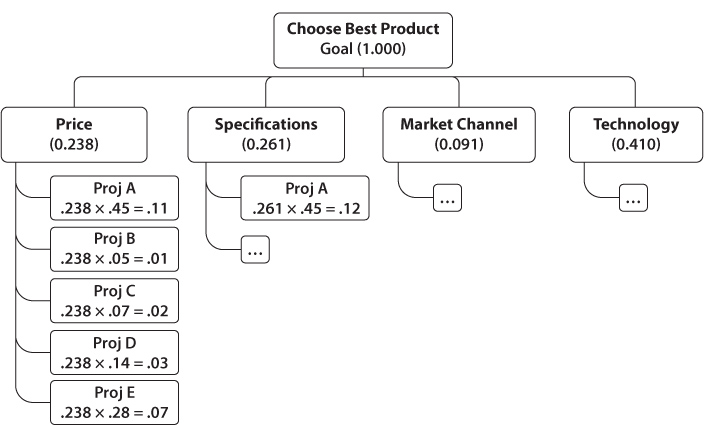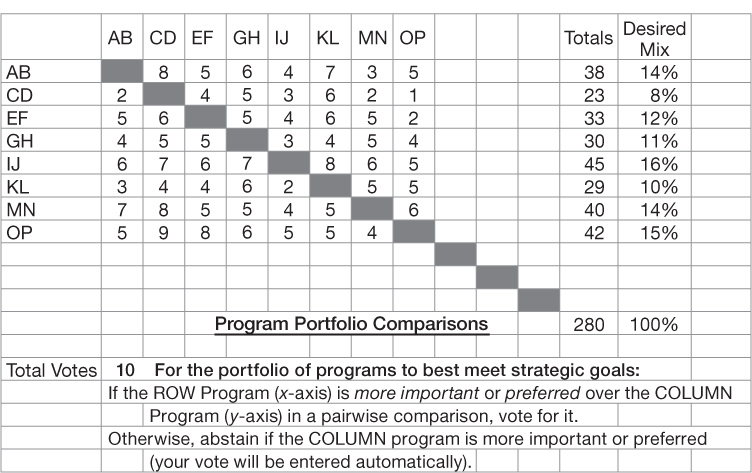Appendix A: Analytical Hierarchy Process
The analytical hierarchy process is as follows:
1. Define the desired goal for the organization’s set of projects.
2. Structure a hierarchy listing criteria under the goal and possible projects under the criteria. A criterion may have subcriteria. Determine the weighting for each criterion.
3. Construct a matrix comparing the relative contribution of each project with that of each other project for each criterion in the next higher level. Use a scale such as that in Table A.1 to indicate relative contribution. If a project does not contribute more than the one it is being compared against for that criterion, enter a reciprocal number (see Table A.2).
4. Obtain all judgments required to develop the matrix in step 3. Multiple judgments can be synthesized by using their geometric mean.
5. Repeat these steps for all levels in the hierarchy.
6. Compute the priorities for the projects, possibly using a computer and matrix algebra (see Saaty, 2012).
For example, say a group of upper managers get together to choose the best new projects for the product family. More choices are available than the organization has the capacity to support. The first task is to identify which criteria to enter into the decision-making process. After give-and-take discussion, it is decided that the criteria are price, key specifications, channel of distribution, and technology risk.
Next, the criteria are ranked according to priority by making pairwise comparisons between them. Which is the more desirable criterion and by how much: A price range or key specifications? Channel of distribution or key specifications? Technology risk or price range? These questions are asked about all possible pairs and recorded in Figure A.2.
TABLE A.1 A Scale for Pairwise Comparisons
Intensity of Importance |
Definition |
Explanation |
1 |
Equal importance |
Two elements contribute equally to the property |
5 |
Essential or strong importance |
Experience and judgment strongly favor one element over another |
9 |
Extreme importance |
The evidence favoring one element over another is of the highest possible order of affirmation |
Reciprocals |
When activity i compared with j is assigned one of the above numbers, then activity j compared with i is assigned its reciprocal. |
|
TABLE A.2 Matrix of Pairwise Comparisons

If five projects (A to E) are contending for the top new product slots as in Table A.2, compare Project A with each of the others on the first criterion, price. In the row for Project C, for example, the team determines that Project A is strongly preferred to C, so the cell gets a 1/6. However, Project C contributes moderately more than Project B, so that cell gets a 2. Project C compared with itself gets a 1.
Log the answers in a grid similar to Table A.2 using the scale from Table A.1. Compare the project along the side with the project across the top; if the side project is preferred over the top project, put a number in the appropriate cell depending on the degree of preference. If the top project is preferred to the side project, invert the number.
Complete the comparison of each project with each other one for the price criterion (see Figure A.1). The priority value for each project is obtained by multiplying its priority score from Table A.2 (0.45 for Project A) with the weighting factor for the criterion (0.238 for price). Then move to the next criterion (specification) and repeat the process. Do the same for the other two criteria. The result is a series of four boxes. The priority scores within each box are compared with the other boxes using the rank-order scoring decided on initially for the criterion. The outcome is one ordered list inclusive of all projects and all criteria. The team then reviews the list for consistency and decides how to proceed. Initially Project A appears top priority. However, once all criteria are scored, a different result may appear.
A detailed explanation for computing the priority scores and the final rank-ordering list according to Saaty (2012) is quite complex, involving eigenvalues and eigenvectors, so it is much easier to get a software package that does the computations. As an alternative, a spreadsheet could be constructed to normalize the numbers.
This process appears complex and analytical but is easy when a software tool handles the computations and the management team concentrates on the comparisons. It is thorough in guiding the team to consider all criteria, both emotional and logical, and to apply them to all projects. The software tool (“Expert Choice,” 2018) also pinpoints the inconsistencies recorded by the team and prompts further discussion to justify the scoring, make adjustments, or correct data entry errors.
This software tool offers several features:
• Team decision tools that allow participation anytime, anywhere in the world
• Project management tools to define participant roles and responsibilities
• Science-based analytics that translate team knowledge, expertise, and intuition into quantitative measures
• Insight and survey tools that resolve conflicting priorities, and achieve stakeholder understanding and consensus
• Structured, transparent decision making and risk assessment processes
• Actionable reporting outputs and improved communications
• Easy-to-use “what-if” scenarios (excerpted from Expert Choice software, 2018)
FIGURE A.1 Hierarchy Showing Prioritized Results for One Criterion

Numbered Pairwise Comparisons
An alternative “poor man’s hierarchy,” as described in Chapter Two, is depicted in Figure A.2. Eight out of ten persons voted for AB over CD, so the other two are recorded in CD over AB. The Desired Mix column shows relative priorities.
FIGURE A.2 Pairwise Comparisons with Voting

Note: Rows AB through OP represent a comparison of each project with each other project for one criterion. The Desired Mix, or priority, column is a calculated result of the comparisons; a higher number represents a higher priority for that project.
